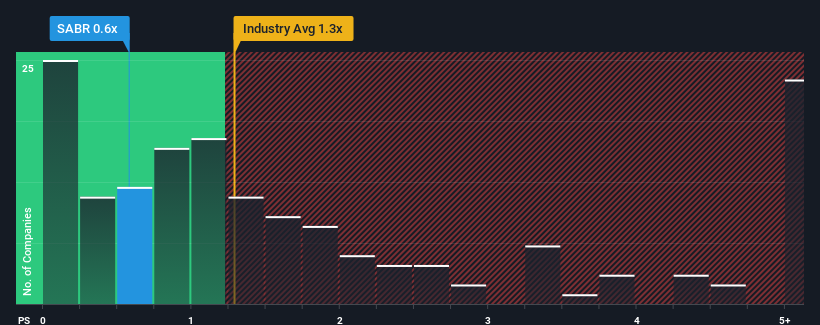- United States
- /
- Hospitality
- /
- NasdaqGS:SABR
Lacklustre Performance Is Driving Sabre Corporation's (NASDAQ:SABR) Low P/S
Sabre Corporation's (NASDAQ:SABR) price-to-sales (or "P/S") ratio of 0.6x may look like a pretty appealing investment opportunity when you consider close to half the companies in the Hospitality industry in the United States have P/S ratios greater than 1.3x. Although, it's not wise to just take the P/S at face value as there may be an explanation why it's limited.
View our latest analysis for Sabre

What Does Sabre's P/S Mean For Shareholders?
With revenue growth that's inferior to most other companies of late, Sabre has been relatively sluggish. The P/S ratio is probably low because investors think this lacklustre revenue performance isn't going to get any better. If this is the case, then existing shareholders will probably struggle to get excited about the future direction of the share price.
Keen to find out how analysts think Sabre's future stacks up against the industry? In that case, our free report is a great place to start.Is There Any Revenue Growth Forecasted For Sabre?
There's an inherent assumption that a company should underperform the industry for P/S ratios like Sabre's to be considered reasonable.
Taking a look back first, we see that the company grew revenue by an impressive 19% last year. Pleasingly, revenue has also lifted 45% in aggregate from three years ago, thanks to the last 12 months of growth. So we can start by confirming that the company has done a great job of growing revenue over that time.
Looking ahead now, revenue is anticipated to climb by 8.0% each year during the coming three years according to the eight analysts following the company. With the industry predicted to deliver 13% growth per annum, the company is positioned for a weaker revenue result.
With this in consideration, its clear as to why Sabre's P/S is falling short industry peers. Apparently many shareholders weren't comfortable holding on while the company is potentially eyeing a less prosperous future.
What Does Sabre's P/S Mean For Investors?
It's argued the price-to-sales ratio is an inferior measure of value within certain industries, but it can be a powerful business sentiment indicator.
As we suspected, our examination of Sabre's analyst forecasts revealed that its inferior revenue outlook is contributing to its low P/S. Shareholders' pessimism on the revenue prospects for the company seems to be the main contributor to the depressed P/S. The company will need a change of fortune to justify the P/S rising higher in the future.
You need to take note of risks, for example - Sabre has 3 warning signs (and 1 which doesn't sit too well with us) we think you should know about.
If these risks are making you reconsider your opinion on Sabre, explore our interactive list of high quality stocks to get an idea of what else is out there.
New: Manage All Your Stock Portfolios in One Place
We've created the ultimate portfolio companion for stock investors, and it's free.
• Connect an unlimited number of Portfolios and see your total in one currency
• Be alerted to new Warning Signs or Risks via email or mobile
• Track the Fair Value of your stocks
Have feedback on this article? Concerned about the content? Get in touch with us directly. Alternatively, email editorial-team (at) simplywallst.com.
This article by Simply Wall St is general in nature. We provide commentary based on historical data and analyst forecasts only using an unbiased methodology and our articles are not intended to be financial advice. It does not constitute a recommendation to buy or sell any stock, and does not take account of your objectives, or your financial situation. We aim to bring you long-term focused analysis driven by fundamental data. Note that our analysis may not factor in the latest price-sensitive company announcements or qualitative material. Simply Wall St has no position in any stocks mentioned.
About NasdaqGS:SABR
Sabre
Operates as a software and technology company for travel industry in the United States, Europe, Asia-Pacific, and internationally.
Undervalued with moderate growth potential.
Similar Companies
Market Insights
Community Narratives



